Christopher Hector sits in on a training session with Australian based Danish professional, Charlotte Pedersen, working with Rafael Soto. Charlotte has spent the last 20 years in Australia, and has ridden a number of good horses, but none more exciting than her huge ten-year-old, Hill Cottage Jazmira – known to her friends as Jazzmin.
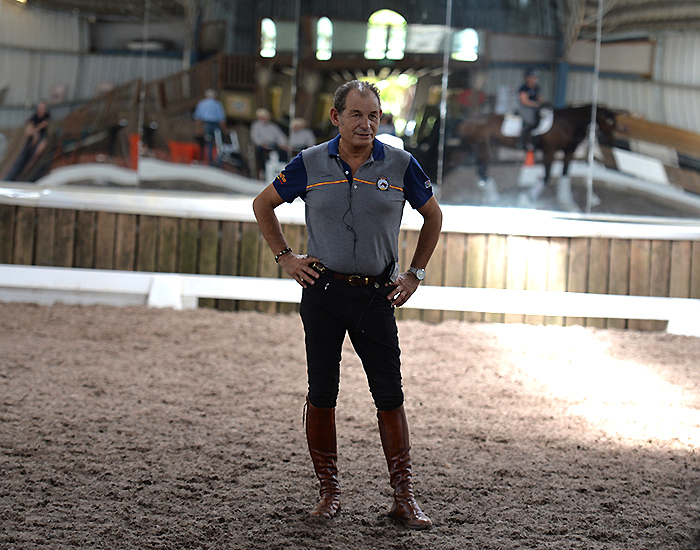
Watching dressage training is pure joy when you combine a brilliant teacher, with a talented horse, and a rider who has the control of her body and mind – to be able to make the adjustments the teacher suggests, and that’s exactly how it was in the Jesmond Dene school at Officer.
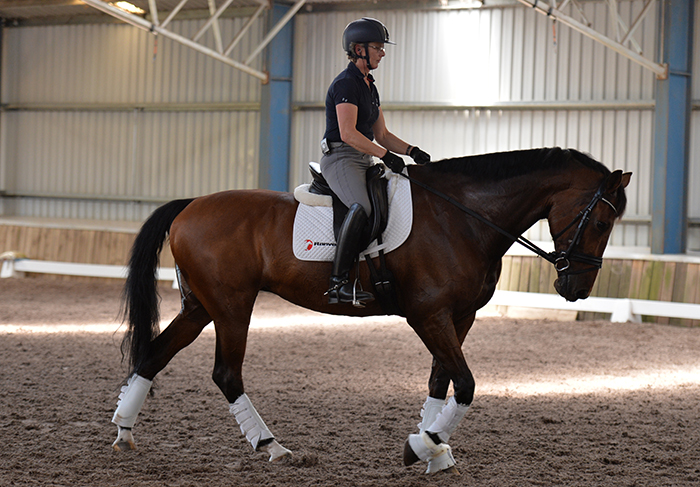
Like all good trainers, Rafael knows the benefit of starting in walk – ‘you learn a lot about the coordination of the aids’ – and Charlotte is off on a little ballet of lateral movements, starting with leg yield.
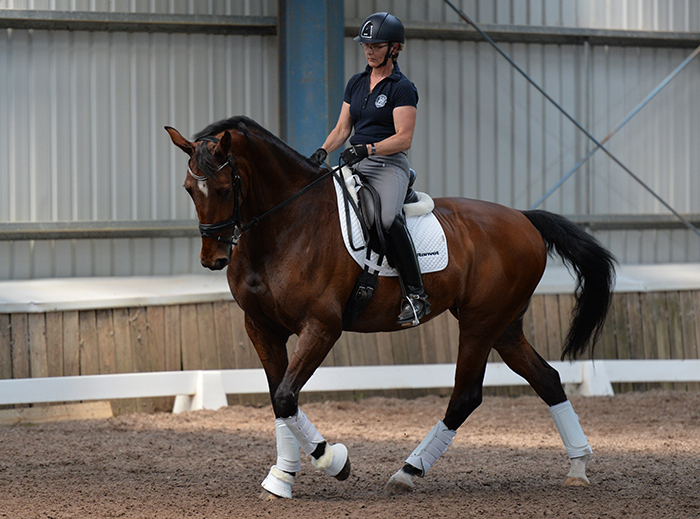
“Ask her to go sideways and make her focus on your legs. The best way is in leg yield, bending on your inside leg. Not too fast or she won’t cross her legs enough.”
“On the long side, shoulder in, haunches in, shoulder in, volte, sometimes bend her to the outside… good now go extended walk.”
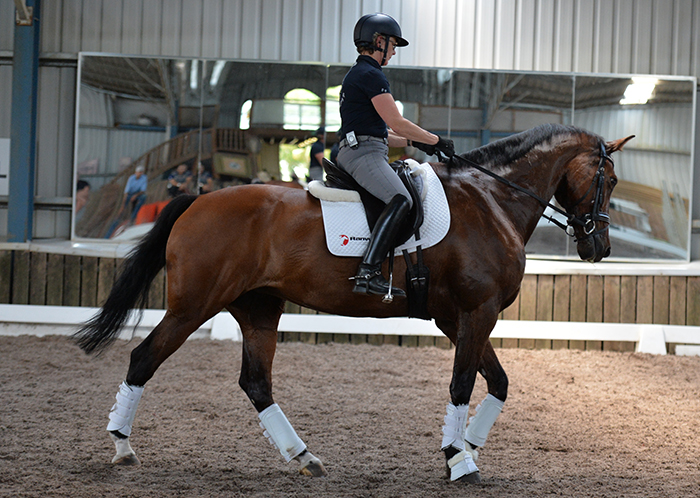
Next day, I asked Rafael to explain what he had been working on with Charlotte:
For a long time, we have had the idea that you came into the arena, and went straight into trot, to get the horse forward, and that walk was something very dangerous that you steered clear of – but you start your sessions with lots of exercises in walk…
“For me, the walk is indispensible. If a horse is not walking correctly – extended, collected, two tracks with all the lateral work – then he doesn’t show that he is relaxed, supple, together. I do it all the time, with young horses, with educated horses, I do some lateral work in walk, some extensions, relaxation and collection, half pirouettes, all this before I come into the trot. It makes the horses calm, makes the rider also calm, it makes the rider coordinate his aids – now I need more bending, less bending, re-balance this half pass, it is indispensible. Also indispensible are the breaks in-between with long reins and free reins. We should start every session in walk – for ten minutes, it should be walk. Not just free reins, working in walk.”
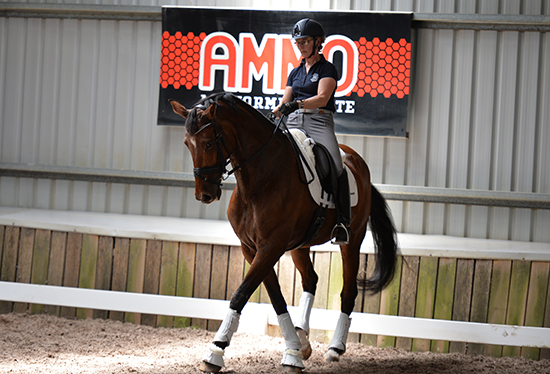
“In the walk you should be working on a good balance for the horse, and different neck positions, more up, more low, more stretched, again more up. This is very important because if you do it, when you start the trot, you have the horse more supple.”
Riders and trainers are often scared of work in walk because they might end up with a lateral walk…
“It’s the opposite for me. If you have a horse with the tendency to lateral walk, if you do a lot of work in walk, he will improve and you will fix this bad walk – the lateral walk comes when the horse is stiff in the back, not supple enough, not using correctly his neck, that’s where the lateral walk comes from. This walk work is not only indispensible to develop a good balance that you can use in the trot and the canter, but also for the horses that have difficulty in the walk. They get very quickly tense and then they start to walk lateral, and this is a very bad habit, and if you want to fix it, you have to go to the walk work.”
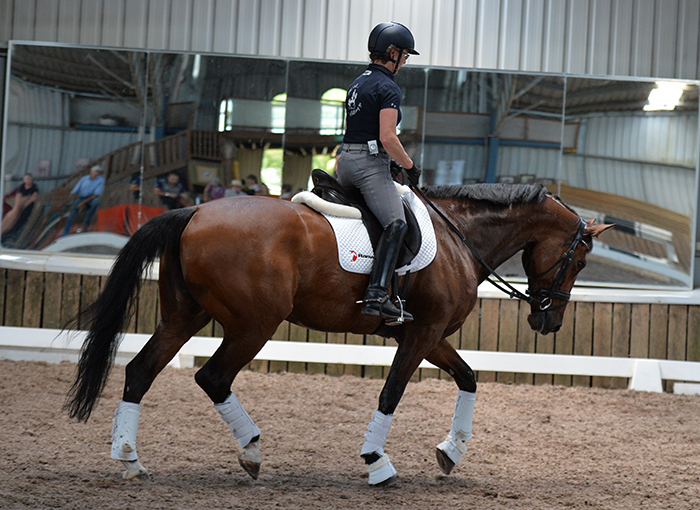
It was time to move on to trot, but before commencing the trot work, Rafael had Charlotte ride some half pirouettes in walk:
“The pirouettes help get the hind legs more under. Before the trot, go a little bit in the way of piaffe to make sure the hind legs are closed. This way we control the horse right from the first steps. For collection all the horse needs is that she is loose and confident.”
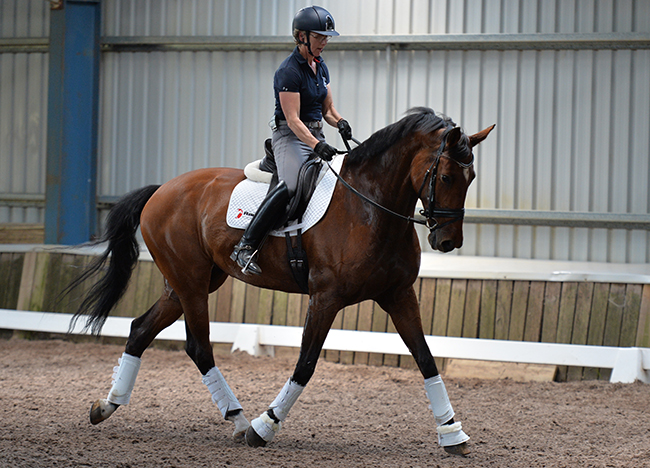
“Trot leg yield, into a ten-metre circle. Go to the quarter line in half pass.”
And all the while in rising trot.
When you went to the trot, it was still the same pattern, leg yield, travers, half pass…
“…Shoulder in, but just in rising trot, that makes the horses coordinate, engage, become supple. Always in the beginning I do that, the lateral work helps the horses become straight and supple. Equal contact on the reins, not stiff, not hanging or pulling, and then when you go to canter you have a much better balance.”
“This is the warming up time, not more than twenty minutes, maybe less, if they are a little hot, then maybe I include some canter. Then I can give them a break with long reins, and then I can start the canter properly, with all the lateral movements, come and go, half passes, haunches in to improve the collection, then if the horse is ready, flying change, or the simple changes. In the last part of the working session, I go to the sitting trot, then I look to the piaffe for engagement, in the sitting trot, half passes, shoulder in, travers, then I always finish with the medium trot.”
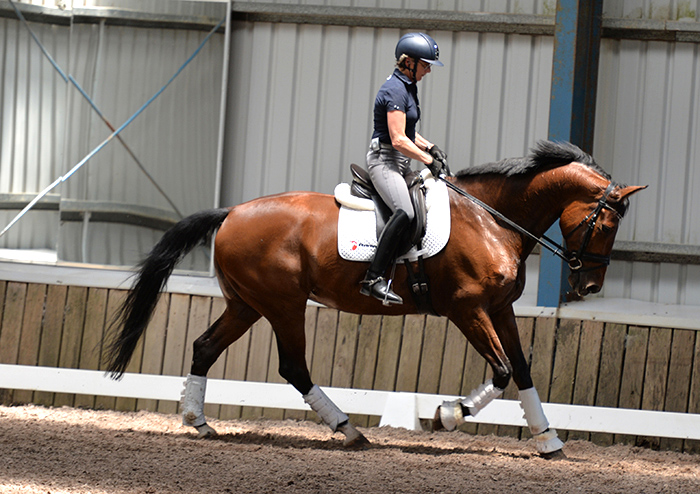
Before the horse struck off in canter, you wanted some little half pirouettes…
“The pirouette makes the horse more collected and more coordinated. I use the half pirouettes in the walk in the warm up as well. In the middle of the canter I use the walk half pirouette, and sometimes the full pirouette, to improve the quality of control, the technique of asking, and letting the horse do. A step you ask, a step you let the horse do, you cannot interfere in the pirouette all the time, and you can see this very easily in the walk. For the rider it is very good because he can see very clearly when he has to interfere, and how and when he has to let the horse do.”
more from Rafael follows
“The great dressage master, Nuno Oliveira said, dressage is ask, and let the horse do. There is always a moment you interfere, and the next second, you let the horse do. This is what it means to say, the horse carries himself.”
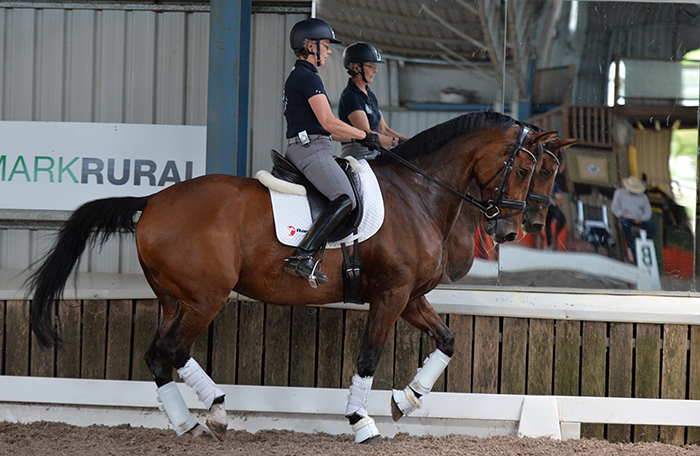
It was interesting that to improve the canter, you used piaffe as a tool – we tend to think of piaffe as the very final movement – the icing on the cake – not a tool to use in training…
“Think about why do we have the piaffe? The piaffe is to train the horses to collect – you don’t ride piaffe just because it is in the Grand Prix test. You use it to train the horse’s body to be collected. If you have a problem with coordination in the canter, then you can go back to piaffe, especially if the horse has a nice piaffe. It doesn’t matter if he hasn’t got a super piaffe, you make the horse more together, and play with piaffe. It’s not to kill them in piaffe, just to make a few steps to make his body more together. After the break, go again to canter, and he is more fresh, easy and together, ready for the flying changes, for the pirouettes – whatever.”
Sure enough, when Jazzmin was having problems with her flying changes, Rafael had Charlotte go to piaffe. “We will improve the change with piaffe, she was not round.”
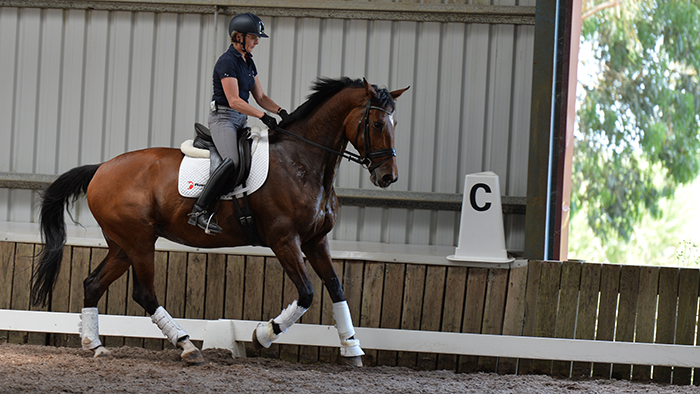
Charlotte was really only having a problem with her one time changes, and only the change to the right – was she blocking a little on the right rein?
“The right change is blocked because the horse is not using her neck correctly in the change. Sometimes it was short, and when the horse was asked for the change, she runs and she doesn’t really come from behind. What Charlotte has to do is make her supple, especially on the left rein, to have more equal contact, and do the half halt, and with the half halt, you open the neck and you use your outside rein and inside leg, and the change will be big and nice…”
All through the training session, Rafael was asking for a longer frame, “in the changes, a long rein, and down. You have a tendency to go up in the change, let her down and relax.”
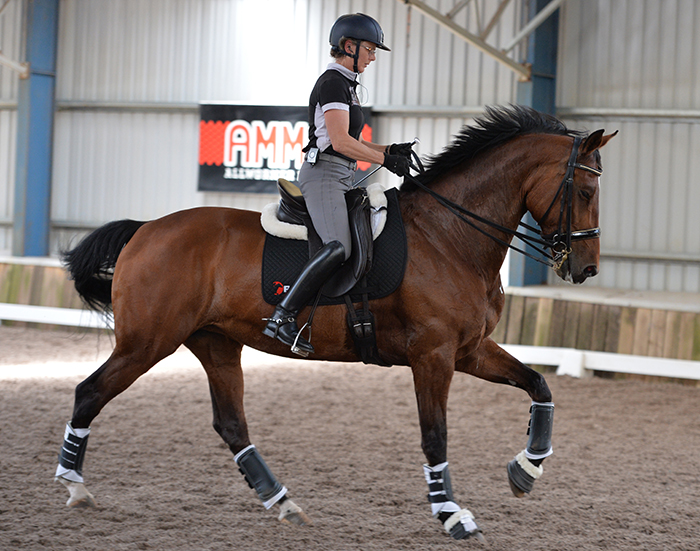
It was very interesting with Charlotte’s horse, the very clear distinction between piaffe and passage, so often we see advancing piaffe instead of passage…
“My father, and my masters they taught me, piaffe is piaffe and passage comes from the trot. I always do first piaffe, then trot, then passage and from passage back to trot, I don’t go to piaffe, some medium trot, some collected trot, and then back to passage. It should be clear, piaffe is piaffe and passage is passage. Piaffe is not passage on the spot, they have different rhythms, piaffe is quicker and passage is more slow.”
More follows below
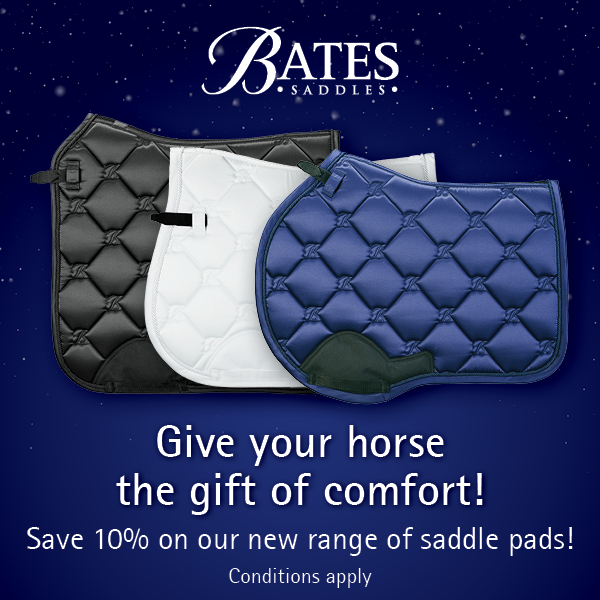
These high performance saddle pads are the ideal partner for any saddle and a wonderful present for your equestrian family or friends. Be sure to purchase your Bates Saddle Pad between 1 November and 24 December 2022 to make the most of this opportunity. Visit www.batessaddles.com to find your nearest stockist or to purchase your Bates Saddle Pad.
You were telling us about your father and your masters, when you were learning were you learning in a Spanish way or in a universal way?
“One time a very old man in Switzerland, a very old master, he said to me, Rafael, there are only two ways of riding in dressage, the good dressage and the bad dressage. With good dressage you can see everything with the horse is natural, easy, fluent. Okay, how good the movements are depends on the quality of the horse, but with every horse you can see, is it over the back, into the hand, it is very clear: good dressage, or not good dressage.”
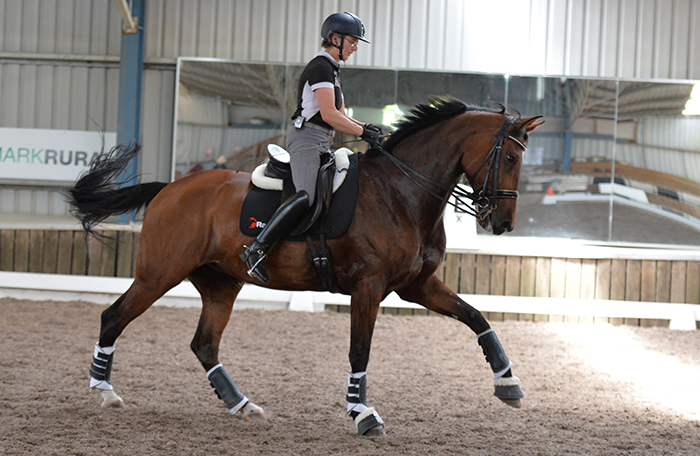
“Good dressage is not forced, it has expression, the horse moves naturally not from tension – just with the correct tension, not over-tension, not under-tension. I am sixty years old now, and I can tell it is true what that old master said, there is just good and bad. No more.”
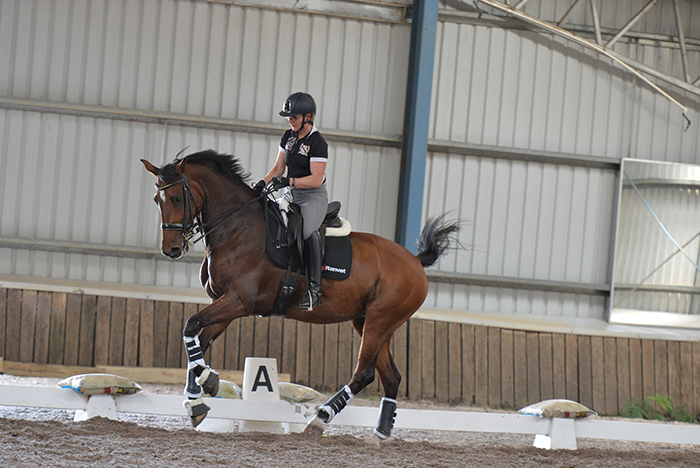
Can you talk me through the sequence you wanted in the flying change? You were saying, half halt, give, both legs – what do you mean both legs?
“Both legs means when you do a flying change to the right, you use your left leg behind – of course – but if you forget to accompany the change to the right, with your right leg on in front, then you stop the supporting leg of the change. The real supporting leg of the flying change is your inside leg – just as the supporting leg of your canter depart is your inside leg. When you forget your inside leg in the canter transition you will not have a nice balanced canter, in the change, it is the same.”
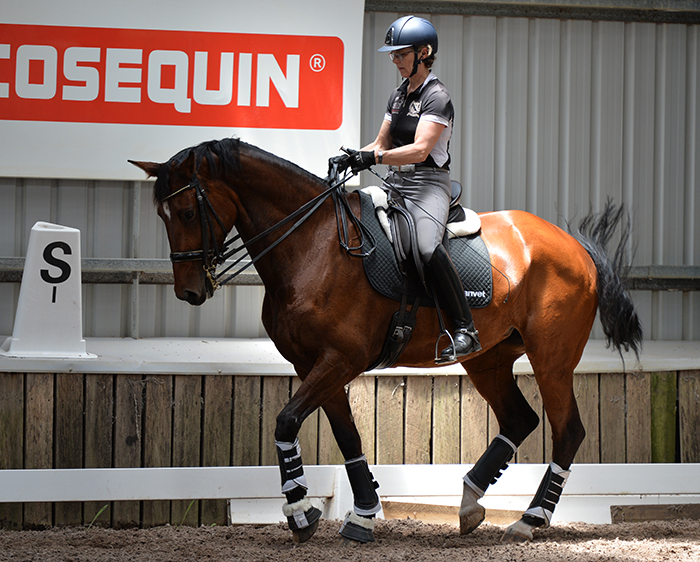
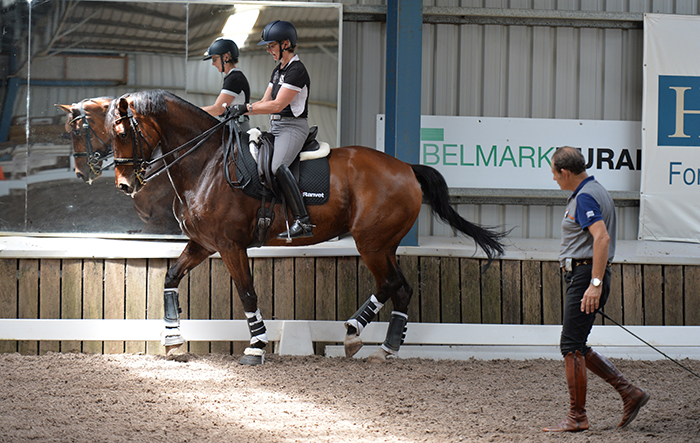
We were talking earlier about how clear Charlotte’s horse is between piaffe and passage but I thought what was so interesting today is how clear she is going from passage to trot – you see so many passagey trots… they learn to do passage and they want to do passage all the time, it becomes an evasion.
“Charlotte sometimes has a little bit flat trot on the half passes, she needs a little more suspension, more quality, so what we tried today was to use the passage in half pass, going from passage in half pass to half pass trot. So the engagement the horse gave you in the passage, you use for the trot to improve the quality. There should be a clear difference between the passage and the trot. We want a trot that has quality, that has enough suspension, enough self-carriage and enough engagement from behind.”
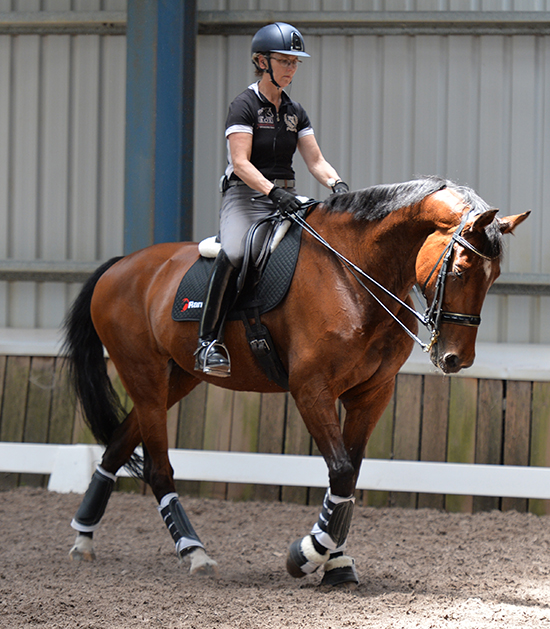
Can we talk a little about contact and the length of the neck?
“All riders shorten the neck. This is why it is important for me, to stretch the horse after you have done a little work in your training session. Work, collection, then stretching and when you stretch the neck do a little two track work, like shoulder in with long reins. It’s very good with long reins, because the horse learns to be together, to be engaged behind but it still has a long neck. This is very good, because normally what we see so often is a short neck.”
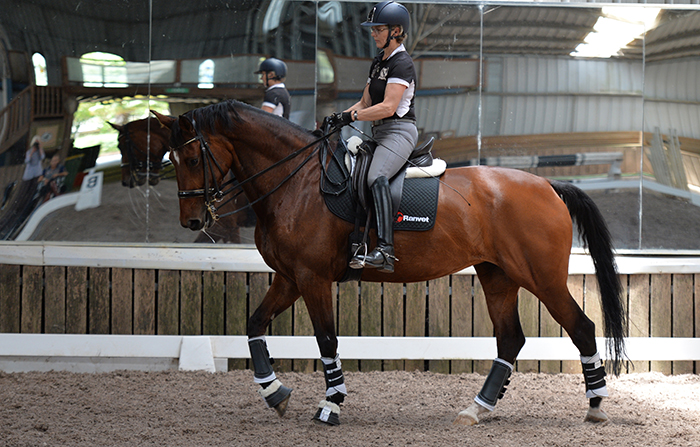
more on long necks follows
Breeding your own dressage star this season? Go to www.ihb.com.au for great stallions like: Furstenball
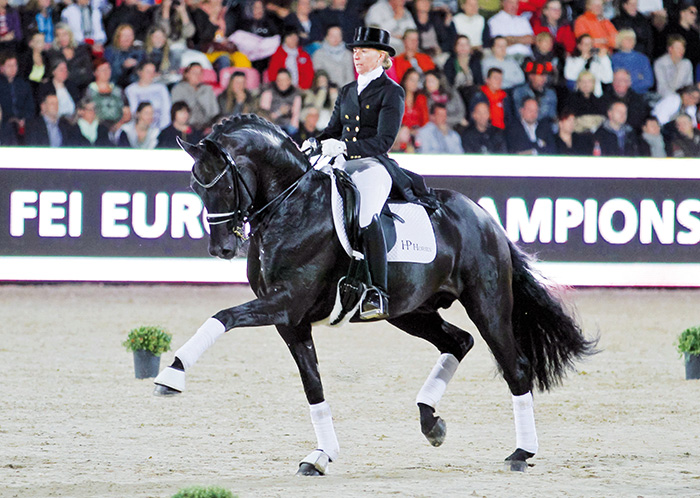
“To have a long neck, means the horse has to be listening to the aids of the rider – you have to be able to give the horse the longer rein, but at the same time you don’t want him to run forward…”
“This is why we do movements, with a long neck, stretching moving, but the horse can still feel the legs and stay in shoulder in without losing the trot, and without going out of the hand. It’s very good that the horse understands that after normal shoulder in and normal half passes, the horse is able to do those movements with a more forward, open neck, and at the same time the horse is still collected from behind. This helps improve the horse’s frame – it gives a nice, natural frame. This is what the judges want, an open frame.”
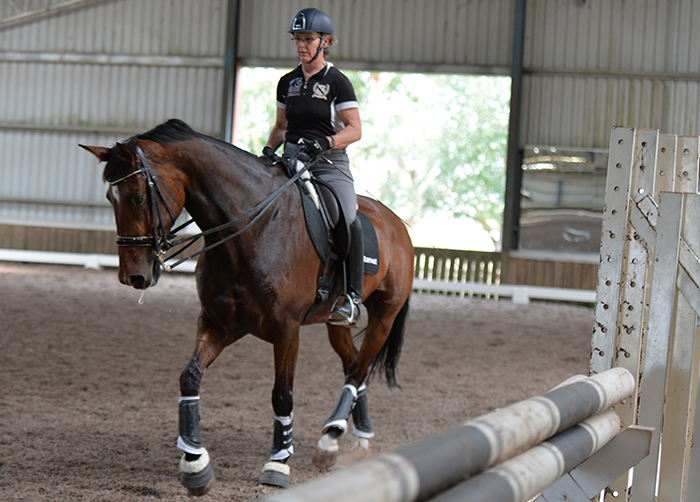
But they don’t see that frame so often…
“They have to see it because it is very clear – when you have a short neck, not letting the back through, it is quite obvious, you can see it. When you have a nice trot with a good connection, still with a nice frame, this is dressage for me. Frame, how the horse comes from behind, the self carriage with a good frame in front, an open frame is very important.”
In one of your earlier lessons, you were getting the rider to put the whip up in the air…
“Like the old masters! Why? That horse is a little bit tricky, when the rider touched him with the whip, he goes against the whip, he jumps with the quarters up and he refused to go forward – then, I remember that my Dad often said to me, with the young horses and they are afraid of the whip, then better to put the whip uphill, and when you want the horse to move forward, just move the whip and make a little noise with it. My Dad always said to me, please don’t touch with the whip, just move the whip and it is a very good aid, the horses understand it well.”
“Think about the race jockeys, many times they touch the horse then put the whip up, because if you touch too many times with the whip then the horse gets tense, they stop, they don’t want to go. With the uphill whip, it is easy to teach them to go forward.”
Is work in hand important for you, to teach the horse to understand the whip and be calm?
“Yeah… they have to be calm with the whip, they have to see the whip like another leg. Work in hand makes them confident to the whip, they know the whip is not to hit them, it is to help them.”
When do you like to start with the work in hand?
“I like to start with it very quick. When the horse is broken and they turn four, then every second day I work a little bit in the hand, a little bit touching, a little shoulder in, stop, rein back, a little piaffe. After they are four years old, you can start, twice or three times a week, a little bit of piaffe, and it is very good, it makes the horses very positive.”
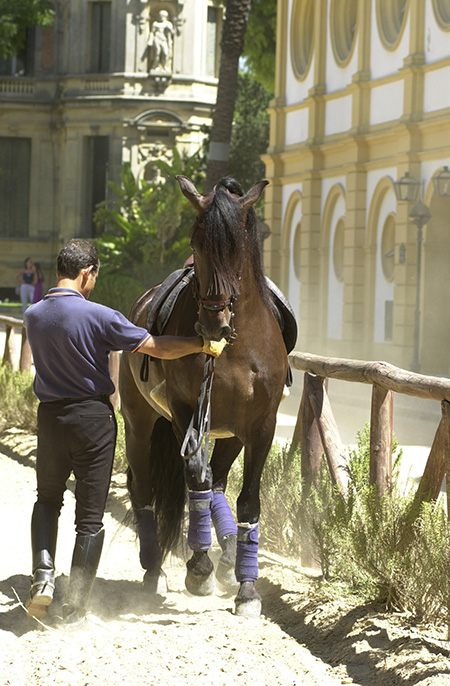
Rafael working with a young horse at the Royal School in Jerez
Do you ever use the pillars?
“I never use the pillars for piaffe. I don’t understand the old tradition to put a horse in the pillars to teach piaffe. I don’t think it works like this. What we do in the school at Jerez – and they do it in Vienna also – they teach piaffe outside the pillars, then when the horse is doing very good piaffe, then you can attach it on the pillars and then they do piaffe. But if you put a horse in pillars, that doesn’t know nothing about piaffe, and you start to touch to piaffe, believe me, it will not work. It might work once out of a hundred horses but it is not a way – piaffe has to be taught on the ground, but always moving forward until he really learns to do the piaffe nearly on the spot, and then some horses are able to go into the pillars and piaffe. This is what we do. I am sixty years old and I never saw anyone train a horse to piaffe in the pillars.”
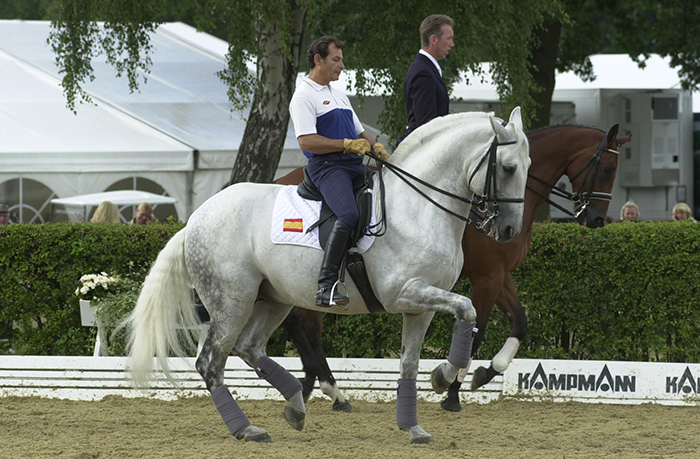
Rafael and Invasor preparing their piaffe at the European Championships in 2001
Is really good piaffe a gift from god? Some horses have it, some don’t…
“Yes, I am sure, yes, but not only the Baroque horses, Spanish horses, Portuguese horses, Lipizzaner horses, also the Warmbloods. I think every horse can piaffe, and every horse should do piaffe because it improves the balance, okay not all the horses can piaffe like Valegro or like my Invasor, but they can all do piaffe. The piaffe is a short trot, a small trot that helps put the body together, this is piaffe, nothing more.”
next day of the clinic and Charlotte rides in a double bridle
Breeding dressage horses? Consider Rock Springs, just one of the many top stallions available from International Horse Breeders: www.ihb.com.au
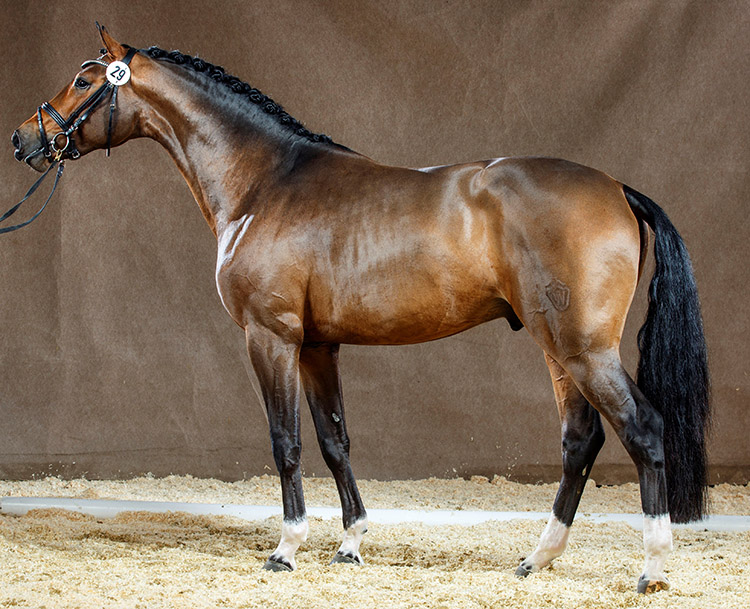
The second day, Rafael had asked Charlotte to ride in a double bridle; “She is very good in the snaffle but she will have to compete in a double…” But even though she is now in a double, the mare is not allowed to get shorter – “A horse who cannot stretch is not trained. The mare has to remember that after collection comes stretching.”
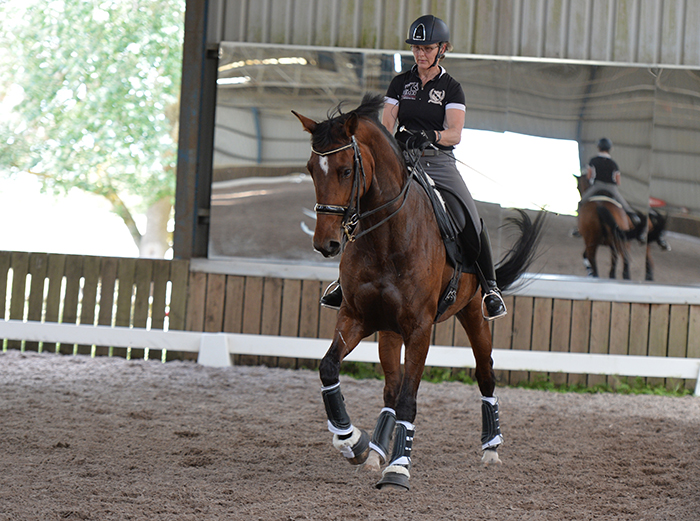
More extraordinary piaffe:
“You must be able to control the piaffe, if you want to walk when she is doing piaffe, then go to shoulder in. It is very good to be able to interrupt the piaffe, you only do as many steps as you want.
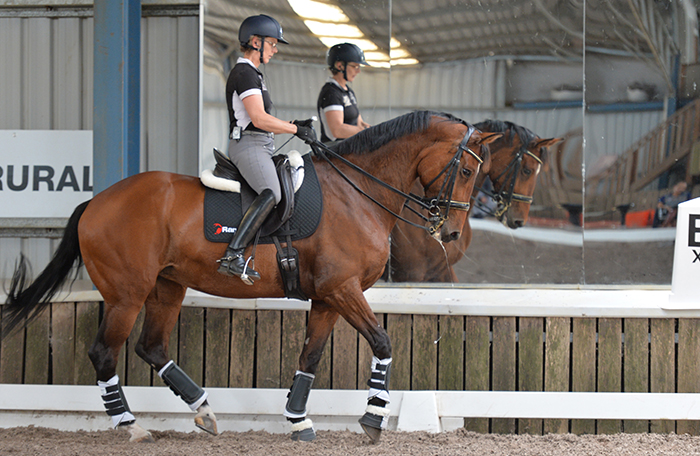
When you were working on the piaffe with Charlotte, you said, when you come out of piaffe to walk, come out in shoulder in, can you talk about that?
“Sometimes horses start to piaffe and they don’t know when to stop – if you want to control the piaffe, you do some steps of piaffe then you come to shoulder in / walk, and the piaffe stops. You bend, then you control the body and then you can tell the horse, stop piaffe. If you stop the aids, the piaffe stops.”
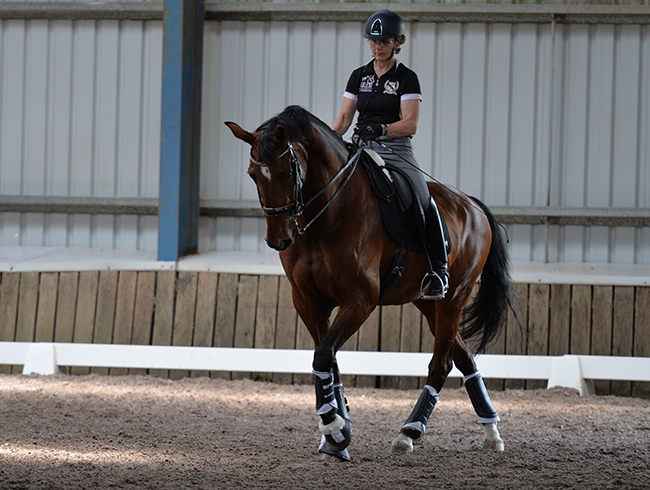
Now some long rein shoulder in: “That’s beautiful, long rein shoulder in is so good for the balance. One of the big problems of dressage is short necks because they don’t do enough lateral work with long reins. Always come back to shoulder in to make the horse light and balanced.”
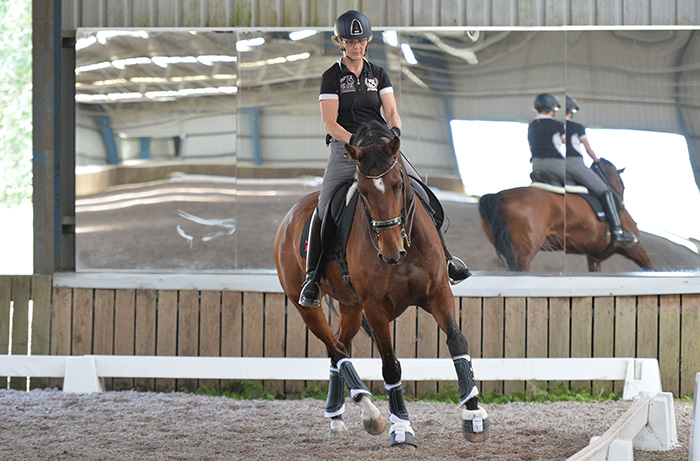
Time for more work on those pesky changes:
“No, you used your hands back. If you don’t open the neck she will shorten the change.”
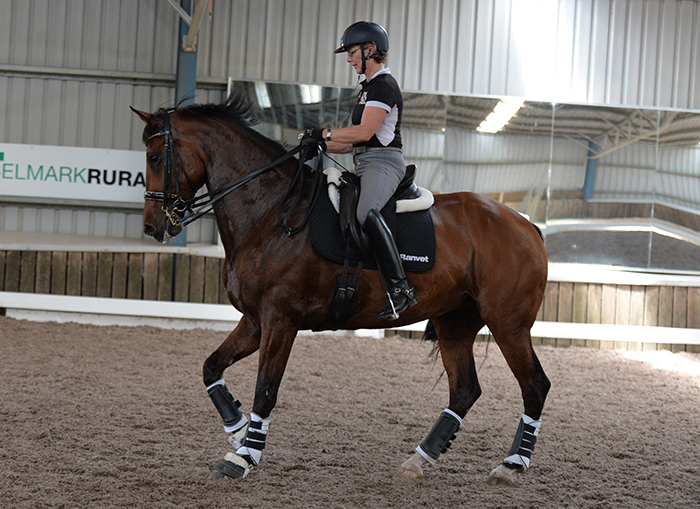
Rafael’s lesson keeps coming up with new moves to help, like his canter square, with quarter pirouettes to form the square in half of the arena : “The quarter pirouettes are very good, when you work on the square they learn to come back and go straight.”
There were some lovely fours, threes, twos, even some ones, but always it was the rider’s responsibility to maintain her position:
“The moment your body goes forward in the flying change, she’s controlling you.”
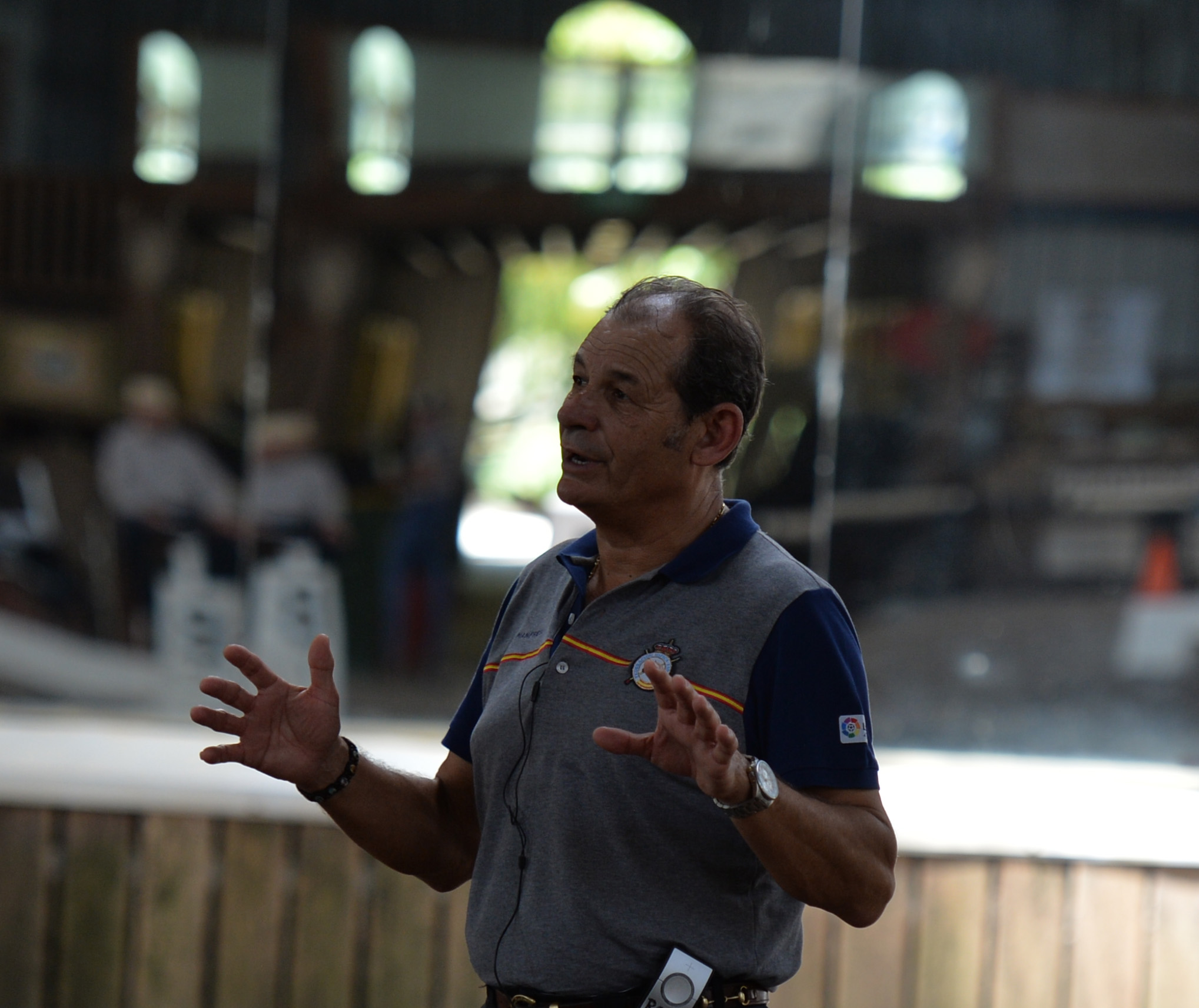
The session finishes with some work on passage, but, of course, it is all in the preparation. “Walk, half pass, straight, half pass, trot half pass, walk half pass, now a little piaffe to make her light in hand, when she gets heavy in the hand, she can’t swing in trot.”
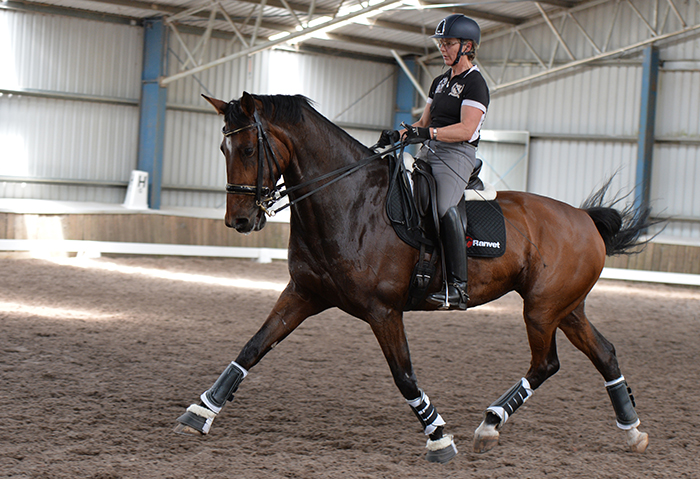
“Now walk half pass, passage half pass, trot half pass, piaffe. Forward, uphill shoulders, now the passage should be up and free. And last of all, the extended trot.”
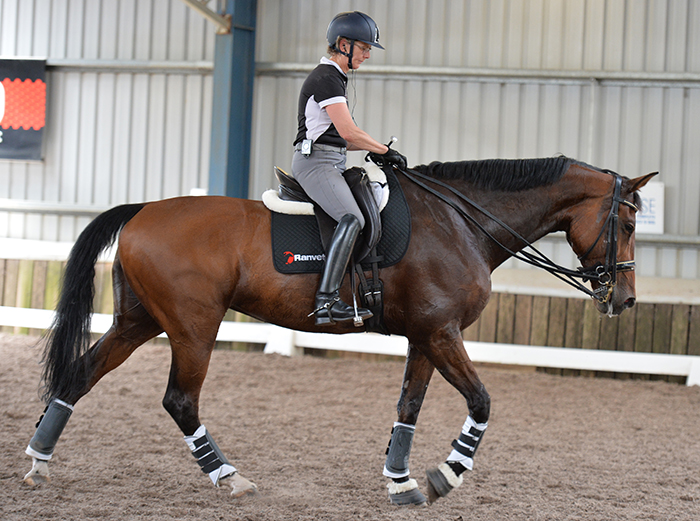
It has been a fairly demanding working session, yet the mare looks happy, calm, and the rider is positively beaming. Thank you Rafael…
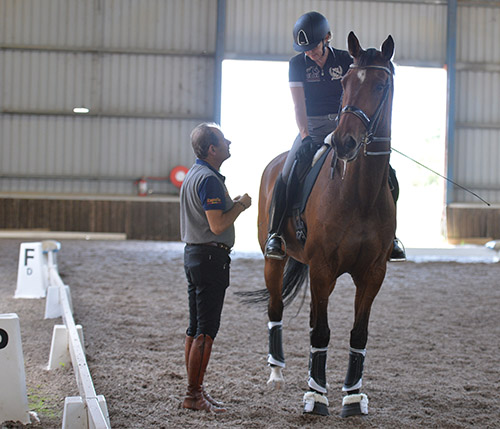
Consider Quantensprung when looking for a dressage stallion: www.ihb.com.au
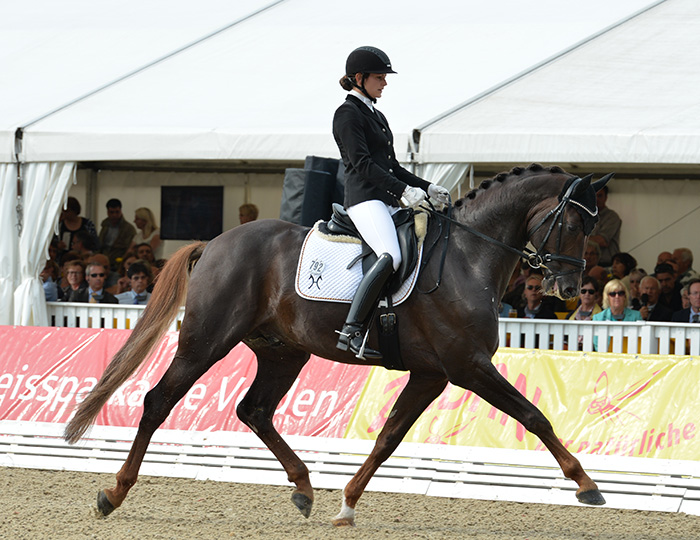



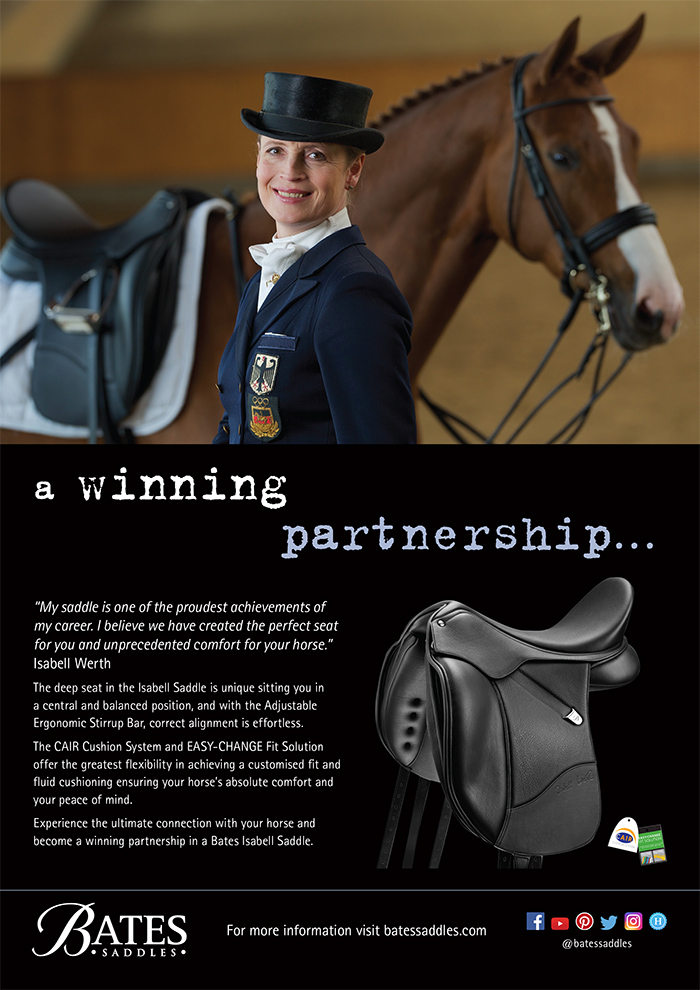
The despairing art “working the horse in the walk “
Think you’re thinking of the Dutch JP. The walk is the cornerstone of classical dressage training with the Pferdewirtschaftmeiters with whom I studied in Germany. Vide: Klimke, Balkenhol, et al.